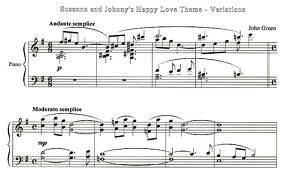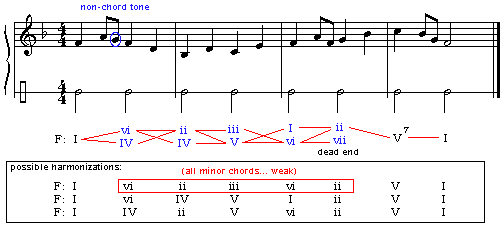Lesson 3 - Harmonizing a Melody

The process of adding chords to a pre-existing melody is similar to the above process for composing a melody to fit a harmonic progression. The following is a simple process to compose a harmonic progression to fit a given melody.
Try to determine what the harmonic pulse is. The harmonic pulse is how often the chords change. In melodies that have faster tempos and melodies that move predominantly by thirds or arpeggiation, the harmonic pulse is frequently a half note or longer.
Common harmonic pulses for various meters are shown below. If the melody appears to outline triads over a two beat pattern, then use a two-beat (half note) harmonic pulse. If the tempo is slow and no chords appear to be outlined, than a harmonic pulse of one chord per note may be appropriate. Example - Harmonic pulse:
For each beat of the harmonic pulse, list all possible chords that could contain most if not all of the notes within that beat.
For single notes, this will be three possible triads (the note will either be the root, third or fifth of a chord). For beats with more than one note, there may be less, or even only one possible chord for that beat. List all of the possible chords, since you can not know for certain which you may need to use yet. When completed, begin at the end, try to compose a harmonic cadence that fits the melody. Complete the last two or three beats.
Now, beginning on I if the melody begins on a down beat or strong beat, or on V if the melody begins on a weak beat, circle the chords that best form a harmonic progression and connect them with a line. You may have two or more possibilities, but find out three chords later that only one of them will work all the way through. When you hit a "dead end" simply back up two or three chords and choose another possible chord.

Stay tuned!
In our next set of lessons we will be dealing with "Primary" and "Secondary" chord usage, a great way to add "color" to your melody!
Back to Lessons.
To be continued!
Determine what the harmonic the harmonic pulse Is!
The harmonic pulse is how often the chords change!
Skills Set to Master
Essential knowledge of major scales increases your knowledge and facility of creating melodies.
Minor ScalesAnother powerfull tool. Just like the major scales, the minor scales gives you additional color and versatility of your melodies.
